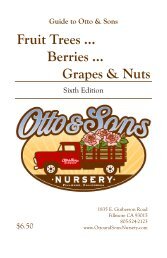You also want an ePaper? Increase the reach of your titles
YUMPU automatically turns print PDFs into web optimized ePapers that Google loves.
Disease & Pest Control<br />
Control Overview<br />
The amount of spraying you do will depend on<br />
your tolerance of diseases <strong>and</strong> pests. Prevention<br />
is the key to a disease free plant. If you have any<br />
questions regarding spray material, check with<br />
your local California Certified <strong>Nursery</strong> Professional<br />
or Cooperative Extension Service for your spray<br />
program. Please do not hesitate to contact us for<br />
suggestions or insights we may have to offer. We<br />
have listed some suggestions below.<br />
When spraying, please make sure that you spray<br />
the roses in the cool early morning so the foliage<br />
won’t be wet overnight. It is important that the<br />
plant’s soil is well watered <strong>and</strong> the leaves are dry<br />
prior to any application.<br />
Some of the “softer” sprays that will control many<br />
diseases are Ultra Fine, <strong>Rose</strong> Defense, <strong>and</strong> Safer<br />
Garden Fungicide. Water can be used effectively to<br />
control many diseases. By washing the rose plant<br />
with water in the early morning, insects <strong>and</strong> fungal<br />
spores will be dislodged from the plant <strong>and</strong> may<br />
reduce their occurrence.<br />
Dormant Spray<br />
When your winter pruning is finished, usually in<br />
January, a good Dormant Spray should be applied.<br />
Volk Oil <strong>and</strong> Kop-R applied thoroughly will reduce<br />
insect eggs <strong>and</strong> fungal spores that over-winter on<br />
your plants.<br />
Beneficial insects <strong>and</strong> mites can also be released<br />
to control pests, but you must be willing to put up<br />
with some pest damage on your roses.<br />
<strong>Rose</strong> Diseases<br />
Powdery Mildew<br />
Powdery mildew is first visible as a white powderlike<br />
substance on the leaf surfaces or flower buds.<br />
New plant growth is the most susceptible to<br />
infection. Infection is most likely when humidity is<br />
high (but no moisture) <strong>and</strong> temperatures are cool.<br />
Look for it during warm days <strong>and</strong> cool nights.<br />
Recommended products for prevention control<br />
are Green Light Fung-Away or Immunox applied as<br />
per the label instructions.<br />
Rust<br />
Rust symptoms generally appear first as orange<br />
powdery spots on the under surface of the leaves.<br />
Rust can cause leaf drop <strong>and</strong> reduce growth.<br />
Recommended products for prevention control<br />
are Immunox, Funginex, or Green Light Fungicide<br />
per label instructions.<br />
Blackspot<br />
Blackspot symptoms are well described by the<br />
name. They appear on the upper side of the leaves<br />
surrounded by yellow tissue. Chlorosis may extend<br />
throughout the leaf before leaf drop occurs.<br />
This fungus disease occurs during cool <strong>and</strong> wet<br />
periods.<br />
Recommended products for prevention control<br />
are Bravado, Funginex, Immunox, <strong>and</strong> Green<br />
light Systemic fungicide. Spray coverage on the<br />
underside of the leaf is important for control.<br />
Botrytis Blight<br />
aka; Grey mold, “Balling”, brown spots on petals<br />
<strong>and</strong> brown cane die-back. The disease occurs<br />
during high humidity <strong>and</strong> cool rainy nights.<br />
Recommended product is Bravado.<br />
Downy Mildew<br />
This can be the most devastating disease for roses.<br />
This disease rarely causes mortality, but it can<br />
cause severe leaf drop. This can necessitate the<br />
restarting of the rose crop with cutting back <strong>and</strong><br />
re-growing.This delay will mean an additional 6<br />
weeks from cutback for flower production.<br />
Symptoms of downy mildew occur on leaves with<br />
the development of purplish red to dark brown<br />
spots. The leaves may turn yellow <strong>and</strong> drop. Leaf<br />
symptoms may resemble black spots or burns<br />
from pesticide toxicity. Under humid conditions<br />
lesions appear in large numbers on the surfaces<br />
of the leaves. Fungicide application must provide<br />
coverage on the bottom of leaves for good control.<br />
Spore reproduction <strong>and</strong> infection slows when the<br />
humidity drops below 85%. In ideal conditions,<br />
spores can multiply in as little as 3 hours. The ideal<br />
condition exists for infection when temperatures<br />
are 55-65 degrees with humidity over 85%.<br />
Control is achieved by lowering the humidity,<br />
raising the temperature <strong>and</strong> preventative<br />
application of fungicide. Since neither the<br />
temperature nor humidity can be controlled<br />
in an outdoor environment, a regular fungicide<br />
application is necessary. A regular application of<br />
Agri-Fos per labeled instructions is recommended.<br />
A program that alternates material such as<br />
Subdue, Agri-Fos <strong>and</strong> Stature has been effective.



